Chances are that just under a nearby rock, you’ll spot a roly-poly pill bug. Encourage a child to take a close look, and introduce a fascinating creature. Gently pick it up and watch as it rolls into a ball and unrolls to take a walk. This cousin to lobsters and crabs sheds its crusty skin and will tickle your hand with its 14 (count ’em!) wiggly legs.
Chances are that just under a nearby rock, you’ll spot a roly-poly pill bug. Encourage a child to take a close look, and introduce a fascinating creature. Gently pick it up and watch as it rolls into a ball and unrolls to take a walk. This cousin to lobsters and crabs sheds its crusty skin and will tickle your hand with its 14 (count ’em!) wiggly legs.
2014 Winner of the REVERE Award from PreK-12 Learning Group, Association of American Publishers!
“Next time you see a sunset, stop and sit down for a while.”
2014 Winner of the REVERE Award from PreK-12 Learning Group, Association of American Publishers!
“Next time you see a sunset, stop and sit down for a while.”
Gardening: with limitations and some success
By Peggy Ashbrook
Posted on 2016-03-14
When the preschool moved, the new location presented many obstacles to gardening with children:
- Sloping ground.
- Mature trees shading much of the area.
- English ivy covered portions of the available area.
- The play area had not yet been constructed so the choice of “where” could not be made.
I turned to the resources of the early childhood education and science education communities to get some advice.
 The National Science Teachers Association’s Learning Center has wonderful forums for asking and providing advice and information on many topics. It is free to all to register! I posted in the Early Childhood forum with a post title of “Gardening at school with young children” and heard from many of you with ideas for making a successful garden.
The National Science Teachers Association’s Learning Center has wonderful forums for asking and providing advice and information on many topics. It is free to all to register! I posted in the Early Childhood forum with a post title of “Gardening at school with young children” and heard from many of you with ideas for making a successful garden.
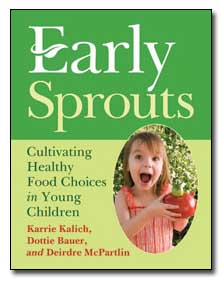 I found beginning instruction and great encouragement in Early Sprouts: Cultivating Healthy Food Choices in Young Children by Karrie Kalich, Dottie Bauer, and Deirdre MdPartlin (2009 Redleaf Press). Reading, “The most important things are a positive attitude and a willingness to try,” and the details about maintaining the garden were motivating. The work of these authors continues at the Early Sprouts Institute.
I found beginning instruction and great encouragement in Early Sprouts: Cultivating Healthy Food Choices in Young Children by Karrie Kalich, Dottie Bauer, and Deirdre MdPartlin (2009 Redleaf Press). Reading, “The most important things are a positive attitude and a willingness to try,” and the details about maintaining the garden were motivating. The work of these authors continues at the Early Sprouts Institute.
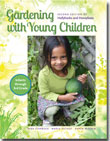 Gardening With Young Children by Sara Starbuck, Marla Olthof, and Karen Midden (2014 Redleaf Press) has supporting information and answers to most of my questions. It was recently reviewed in the Early Childhood Resources Review column in the November 2015 issue of Science and Children (NSTA members can view the review by Gail Laubenthal in the digital version of the journal).
Gardening With Young Children by Sara Starbuck, Marla Olthof, and Karen Midden (2014 Redleaf Press) has supporting information and answers to most of my questions. It was recently reviewed in the Early Childhood Resources Review column in the November 2015 issue of Science and Children (NSTA members can view the review by Gail Laubenthal in the digital version of the journal).
The National Gardening Association published Garden Adventures: Exploring Plants with Young Children by Sarah Pounders (2010), and you can see a KidsGardening.org list of suggested books here.
 The “interim” plan has turned into a long-term plan. We continue with two large pots that nestle next to the fence, in an area that receives about 6 hours of direct sunlight a day, half of it in the afternoon. The successful crops have been a few spinach plants that overwintered without any help from gardeners, and this spring we have a thriving crop of sugar snap peas. We transplanted seedlings grown inside after observing the sprouting seeds. I’m cautiously optimistic that we’ll be able to harvest a handful of pods in late May! It’s a beginning we can grow on.
The “interim” plan has turned into a long-term plan. We continue with two large pots that nestle next to the fence, in an area that receives about 6 hours of direct sunlight a day, half of it in the afternoon. The successful crops have been a few spinach plants that overwintered without any help from gardeners, and this spring we have a thriving crop of sugar snap peas. We transplanted seedlings grown inside after observing the sprouting seeds. I’m cautiously optimistic that we’ll be able to harvest a handful of pods in late May! It’s a beginning we can grow on.
When the preschool moved, the new location presented many obstacles to gardening with children:
- Sloping ground.
- Mature trees shading much of the area.
- English ivy covered portions of the available area.
- The play area had not yet been constructed so the choice of “where” could not be made.
I turned to the resources of the early childhood education and science education communities to get some advice.
Ideas and information from NSTA's March K-12 journals
By Mary Bigelow
Posted on 2016-03-13
This month, all three K-12 journals include What We Call Misconceptions May Be Necessary Stepping-Stones Toward Making Sense of the World (a must-read) and Outstanding Science Trade Books for Students K–12 (a must-share).
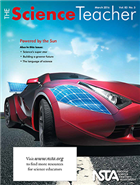 The Science Teacher – Powered by the Sun
The Science Teacher – Powered by the Sun
Most of the lessons in TST include a detailed chart connecting the lesson to the NGSS.
- Science’s Super Star is not about celestial bodies—but the starlet sea anemone. The article describes how to culture these organisms in the classroom and the types of research students can conduct on their reproduction, growth and development, regeneration, and reactions to stimuli.
- Does It Mix? Introduces students to the concepts of hydrophilic and hydrophobic molecules.
- Building a Greener Future connects engineering and science in a project to design, construct, and test compost bins for a community garden.
- Science 2.0: Mastering Scientific Practices With Technology, Part 2 recommends technology tools that support the NGSS science and engineering practices of analyzing and interpreting data, using mathematics and computational thinking, and constructing explanations and designing solutions.
- Idea Bank: Using Earthquakes as “Teachable Moments” has a source of real-time information and data on earthquakes (the presentations are also available in Spanish). There are three entries to date for 2016. http://www.iris.edu/hq/retm/
- Powered by the Sun includes many photographs of an engineering challenge in which students designed, built, and tested solar-powered vehicles (with electric motors, solar cells, gears, and wheels).
For more on the content that provides a context for these projects and strategies see the SciLinks topics Cnidarians, Emulsions, Forces and Motion, Graphing Data, Math and Science, Measurements and Data, Solar Energy, Solubility, Solutions.
Continue for Science and Children and Science Scope.
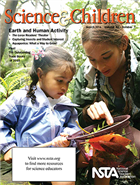 Science and Children- Earth and Human Activity
Science and Children- Earth and Human Activity
Spring is a perfect time for the featured lessons here on the connections between human behavior and the environment. Most of the lessons include a detailed chart connecting the lesson to the NGSS.
- The Lorax Readers’ Theater has an example of how to integrate literature and science, using a popular book.
- Capturing Insects and Student Interest builds on the interest students have in carnivorous plants through investigating, learning centers, and creating illustrated descriptions.
- Students explore sustainability in Aquaponics: What a Way to Grow! by designing and building aquaponic systems. The article has photos of the results of this 5E lesson.
- Understanding Human Impact is the focus of a lesson in which students learn about watersheds and the effect of human activity on the living things and the quality of the environment.
- Students take the role of marine biologist in the 5E lesson Crabby Interactions to study the impact of human activity on the blue crab and its environment.
- Teaching Through Trade Books: Humans and the Earth includes two lessons that trace objects to their origins (K-2) and study the impacts of natural disasters, specifically earthquakes (3-5). Trade books also are the basis for activities in Engineering Encounters: The Cat in the Hat Builds Satellites
- The Early Years: Composting With Children shows how young scientists can explore how materials decompose and how composting recycles these materials.
- Formative Assessment Probes: Is It Erosion or Weathering? explores differences between these two concepts that students may think are the same.
For more on the content that provides a context for these projects and strategies see the SciLinks topics Adaptations of Plants, Aquatic Plants and Animals, Arthropods, Composting, Decomposers, Deposition, Earthquakes, Earthquakes and Society, Erosion, Hydroponics, Natural Resources, Stream Deposition, Water Erosion, Watersheds, Weathering and Erosion, Wind Erosion.
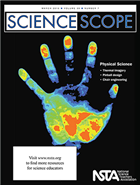 Science Scope – Physical Science
Science Scope – Physical Science
From new elements to engineering designs to technology enhancements, physical science and its applications are interesting to students (and teachers). Most of the lessons include a detailed chart connecting the lesson to the NGSS.
- Exposing Hidden Energy Transfer With Inexpensive Thermal Imaging Cameras uses this technology to help students understand and capture images of “missing” energy.
- If your students are new to problem-based learning, Chemical Connections: A Problem-Based Learning, STEM Experience provides a step-by-step example and advice that could apply to a variety of subject areas.
- Pinball Wizards illustrates a project in which students collaborated on designing and constructing a mechanical pinball machine,
- In another design project, Build Your Own Sunglasses, students apply what they’ve learned about light and UV radiation to design eye protection.
- Everyday Engineering: Sitting Around Designing Chairs presents a 5E lesson that challenges students do design a structure made of paper that will support their weights.
- Add some sparks to your unit on electricity with Tried and True: Measuring Static Electricity: A Classroom Investigation to Understand the Triboelectric Series.
- Take your students to a interdisciplinary level with Teacher’s Toolkit: A Framework for Cross-Disciplinary Engineering Projects with ideas for designing marble ramps and marshmallow towers.
For more on the content that provides a context for these projects and strategies see the SciLinks topics Forces and Motion, Heat Energy, Radiation from the Sun, Simple Machines, Static Electricity, Transfer of Energy, UV Index.
This month, all three K-12 journals include What We Call Misconceptions May Be Necessary Stepping-Stones Toward Making Sense of the World (a must-read) and Outstanding Science Trade Books for Students K–12 (a must-share).
You Won't See This List on Buzzfeed: Events for Middle School Teachers at NSTA's National Conference
By Lauren Jonas, NSTA Assistant Executive Director
Posted on 2016-03-13
If you teach middle school science, you need to be in Nashville for the NSTA National Conference on Science Education, March 31–April 3. You’ll be with thousands of your fellow teachers for the week and take home tried-and-true strategies for everything from creating maker spaces to breaking down lessons for diverse communities of learners. There will be an entire day devoted to middle school teachers and hundreds of other sessions throughout the rest of the conference. Teach your students about circuits and electricity with Sewing Science: Using Electronic Textiles Technology to Teach Electricity and Circuits or face the Zombie Apocalypse session to learn more about how disease spreads using simulations and models. We have something for every middle school teacher, no matter if you’re just starting out or been at the job for years. Check out the events below to get a sense of what we’ve got in store, and browse all the sessions here (more than 1000 of them!) to see all that we have to offer.
Meet Me in the Middle Day
Saturday, April 2 10:15 AM–4:00 PM| Omni Nashville Hotel
- The day’s events will include a networking session, more than a dozen presentations specifically for middle school educators, and an afternoon share-a-thon featuring more than 100 presenters. You’ll walk away with ideas you can put to use in your classroom next week! [Organized by the National Middle Level Science Teachers Association (NMLSTA) and sponsored by Carolina Biological Supply, PASCO scientific, and Texas Instruments]
Middle School Science with Vernier
- Use Vernier sensors, including our Go Wireless sensors, to conduct a variety of age-appropriate experiments in this engaging, hands-on workshop. Experience data collection using LabQuest 2, Logger Pro computer software, Chromebook, and mobile devices. Explore the wide range of tools from Vernier that promote understanding of middle school science concepts.
Sewing Science: Using Electronic Textiles Technology to Teach Electricity and Circuits
- Learn how to engage students in circuits and electricity though sewing! Research shows how electronic textiles are an effective way to engage girls and others in science.
Bumpers Save Lives
- In this hands-on and very active session, experience the science behind the materials selected for car bumpers. Apply those concepts to engineer a car bumper. Bumpers will be tested and analyzed to determine the best design solution. Take home CD of lesson plans and resources.
Zombie Apocalypse!
- Become part of a zombie apocalypse as brains will be served (while supplies last). Learn about disease spread modeling using simulations and fun storylines about a zombie outbreak. Applicable for middle school and high school, this workshop is sure to scare you and your little zombies into learning how exciting Hollywood themes can be used to teach science concepts.
Amplify Science for Grades 6–8: Experience Three-Dimensional Teaching and Learning with the Newest Curriculum from The Lawrence Hall of Science
- Experience our field-tested, technology-enhanced, 100% NGSS-designed K–8 curriculum. Built around argumentation, digital simulations, modeling tools, hands-on investigations, and explicit disciplinary literacy instruction, Amplify Science engages students with deep dives into understanding the natural and designed worlds. Focusing on middle school, this workshop provides a sneak peek.
Modeling Energy Flow in Ecosystems: Developing Models in Middle School Life Science
- How is matter conserved, and how does energy flow through an ecosystem? Develop these models through hands-on activities. Take home a set of student materials, overview instructional strategies for scientific practices, and preview online activities and NGSS connections in the newly revised FOSS Populations and Ecosystems Course for middle school.
Meet Me in the Middle Session: Use Science to Support and Develop ELL Language Acquisition
- The NGSS supports science learning for all students. We will focus on English language learners and the language support and discourse strategies that engage all students regardless of their English proficiency. Activities will be geared toward developing a classroom culture that ensures that all student voices are included and respected. Take home engaging lessons.
Register to attend #NSTA16 Nashville here—and don’t forget, NSTA members get a substantial discount!
The mission of NSTA is to promote excellence and innovation in science teaching and learning for all.
Future NSTA Conferences
2016 National Conference
2016 STEM Forum & Expo
2016 Area Conferences
Follow NSTA
• hands-on science activities with engaging titles such as “Mountain Mayhem,” “Oceans on the Move,” and “Trash Soup”;
• readings that cover important Earth science concepts and support the Next Generation Science Standards;
• hands-on science activities with engaging titles such as “Mountain Mayhem,” “Oceans on the Move,” and “Trash Soup”;
• readings that cover important Earth science concepts and support the Next Generation Science Standards;




